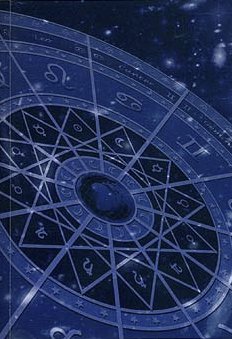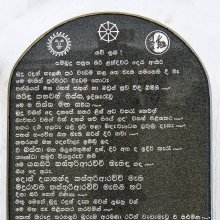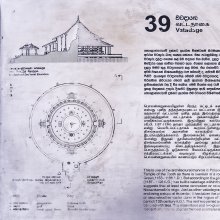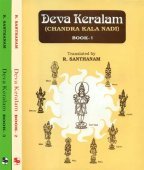Nava, Nāvā, Nāva, Navā, Navan: 42 definitions
Introduction:
Nava means something in Buddhism, Pali, Hinduism, Sanskrit, Jainism, Prakrit, the history of ancient India, Marathi, Hindi, biology. If you want to know the exact meaning, history, etymology or English translation of this term then check out the descriptions on this page. Add your comment or reference to a book if you want to contribute to this summary article.
Images (photo gallery)
(+3 more images available)
In Hinduism
Purana and Itihasa (epic history)
Source: Cologne Digital Sanskrit Dictionaries: The Purana Index1a) Nava (नव).—A son of Svārociṣa Maru.*
- * Brahmāṇḍa-purāṇa II. 36. 19.
1b) A son of Navā and Uśīnara; chief of Navarāṣṭra.*
- * Brahmāṇḍa-purāṇa III. 74. 19 and 21; Matsya-purāṇa 48. 18 and 21; Vāyu-purāṇa 99. 20, 22. Viṣṇu-purāṇa IV. 18. 9.
2) Navā (नवा).—One of the five queens of Uśīnara and mother of Nava.*
- * Brahmāṇḍa-purāṇa III. 74. 18-19; Matsya-purāṇa 48. 16. 18; Vāyu-purāṇa 99. 19-20.

The Purana (पुराण, purāṇas) refers to Sanskrit literature preserving ancient India’s vast cultural history, including historical legends, religious ceremonies, various arts and sciences. The eighteen mahapuranas total over 400,000 shlokas (metrical couplets) and date to at least several centuries BCE.
Ayurveda (science of life)
Nighantu (Synonyms and Characteristics of Drugs and technical terms)
Source: Wisdom Library: Raj NighantuNava (नव) refers to a “young leaf” of a tree or plant, as mentioned in a list of four synonyms, according to the second chapter (dharaṇyādi-varga) of the 13th-century Raj Nighantu or Rājanighaṇṭu (an Ayurvedic encyclopedia). The Dharaṇyādi-varga covers the lands, soil, mountains, jungles and vegetation’s relations between trees [viz., Nava] and plants and substances, with their various kinds.
Source: WorldCat: Rāj nighaṇṭuNava (नव) is another name for Raktapunarnavā, a medicinal plant identified with Boerhaavia diffusa Linn. or “red spiderling” from the Nyctaginaceae or “four o'clock” family of flowering plants, according to verse 5.117-120 of the 13th-century Raj Nighantu or Rājanighaṇṭu. The fifth chapter (parpaṭādi-varga) of this book enumerates sixty varieties of smaller plants (kṣudra-kṣupa). Together with the names Nava and Raktapunarnavā, there are a total of twenty-two Sanskrit synonyms identified for this plant.
Unclassified Ayurveda definitions
Source: archive.org: Vagbhata’s Ashtanga Hridaya Samhita (first 5 chapters)Nava (नव) means “of the same day”, as mentioned in verse 5.35-36 of the Aṣṭāṅgahṛdayasaṃhitā (Sūtrasthāna) by Vāgbhaṭa.—Accordingly, “[...] fresh butter of the same day [viz., nava] (is) viriligenio, cooling, productive of colour, strength, and digestion, constipating, (and) destructive of wind, hemorrhage, consumption, hemorrhoids, hemiplegia of the face, and cough; [...]”.
Note: Nava, explained by Indu as “sadya uddhṛtam”—“churned on the same day”, has been translated by ’phral, a noun denoting immediate nearness either in space or in time. For ’phral-gyi N reads, less correctly, ’phral-gyis.

Āyurveda (आयुर्वेद, ayurveda) is a branch of Indian science dealing with medicine, herbalism, taxology, anatomy, surgery, alchemy and related topics. Traditional practice of Āyurveda in ancient India dates back to at least the first millenium BC. Literature is commonly written in Sanskrit using various poetic metres.
Jyotisha (astronomy and astrology)
Source: Wisdom Library: Brihat Samhita by VarahamihiraNava (नव) refers to “nine” types of Ketus (i.e., luminous bodies such as comets and meteors), according to the Bṛhatsaṃhitā (chapter 11), an encyclopedic Sanskrit work written by Varāhamihira mainly focusing on the science of ancient Indian astronomy astronomy (Jyotiṣa).—Accordingly, “The comets that resemble a headless trunk are named Kabandha Ketus; they are the sons of Yama, are 96 in number and are without discs; when they appear there will be much fear all over the Earth. The comets that are white possessing a single disc [i.e., śukla-vipula-ekatārā] are 9 in number [i.e., nava]; they appear in the four corners. Thus we have given an account of 1,000 Ketus. We shall now give a few particulars connected with them”.

Jyotisha (ज्योतिष, jyotiṣa or jyotish) refers to ‘astronomy’ or “Vedic astrology” and represents the fifth of the six Vedangas (additional sciences to be studied along with the Vedas). Jyotisha concerns itself with the study and prediction of the movements of celestial bodies, in order to calculate the auspicious time for rituals and ceremonies.
Shaivism (Shaiva philosophy)
Source: Brill: Śaivism and the Tantric Traditions1) Nava (नव) or Navavrata refers to the “nine (ascetic observances)”, according to verse 21.4-5 of the Brahmayāmala-tantra (or Picumata), an early 7th century Śaiva text consisting of twelve-thousand verses.—Accordingly, “These are the nine ascetic observances [i.e., nava-vrata], corresponding to [the syllables of] the Vidyā [, Caṇḍā Kāpālinī’s nine-syllable mantra]. I shall now teach you how to perform them correctly, O Mahādevī. Listen to me [while I] teach you”.
Note: These [navavrata—‘nine observances’] are in fact called the vidyāvratas in 21.10c, 42d, 47a, 51b, 53b, 75d and 102d; the nine types of observances obviously correspond to the nine syllables of the Navākṣaravidyā (oṃ caṇḍe kāpālini svāhā), taught in Brahmayāmala-tantra 2; [...].
2) Navan (नवन्) or Navākṣarā refers to “nine (syllables)”, according to the same Brahmayāmala.—Patterning the processes of inner and outer ritual is the Brahmayāmala’s pantheon of mantra-deities, whose core comprises the Four Goddesses or Guhyakās, Four Consorts or Handmaidens, and their lord, Kapālīśabhairava. Secondary members of the pantheon are a sextet of Yoginīs and an octad of Mother-goddesses. These are the mantra-elements manipulated in all practice, both inner and outer, and their permutations are the principal ritual variables. Collectively, the deities comprise the Nine-Syllable Vidyā (navan-akṣarā), mantra of the supreme goddess, Caṇḍā Kāpālinī,
2) Nava (नव) or Navamārga refers to a “new (path)”, according to Utpaladeva’s Īśvarapratyabhijñākārikā verse 4.16ab.—Accordingly, “Thus I have set forth this new, easy path (nava-mārga—mārgo navo) as it was explained by my distinguished teacher [Somānanda] in the śāstra, [entitled] the Śivadṛṣṭi”.
Note: in the Īśvarapratyabhijñākārikāvṛtti, Utpaladeva glosses the term “new” (nava) with the synonym abhinava; and Abhinavagupta reproduces this latter term in the shorter of his two sub-commentaries, the Īśvarapratyabhijñāvimarśinī, where he adds that the path in question is both “included in” all the various secret śāstras and, because it has been concealed from public view, is not well known.

Shaiva (शैव, śaiva) or Shaivism (śaivism) represents a tradition of Hinduism worshiping Shiva as the supreme being. Closely related to Shaktism, Shaiva literature includes a range of scriptures, including Tantras, while the root of this tradition may be traced back to the ancient Vedas.
Shaktism (Shakta philosophy)
Source: Google Books: Manthanabhairavatantram1) Navan (नवन्) or Navaprakāra refers to the “nine aspects” (of the Goddess), according to the Kularatnapañcakāvatāra verse 1.23cd-33ab.—Accordingly, “Sound, touch, form, flavour, smell, mind, intellect, ego, and Karma, which is considered to be the ninth—the goddess has assumed nine aspects (navan-prakāra-gatā) and (she is) my pervasive power. She brings about (this) multifarious wonder in the three worlds by means of (her) Māyā. Due to (that) will, which is supreme and most inferior, the entire universe is pervaded by these (nine). O dear one, pleasure and pain arise and fall away. [...]”.
2) Navan (नवन्) or Navakaula refers to the “Nine Kaulas”.—Kaula is the Absolute devoid of all phenomenal characteristics. The foundation of all things, it cannot be characterized positively as any particular thing, however abstract, whether subjective consciousness or objective Being. All that can be said of it is what it is not. Accordingly, the first part of this hymn eulogizes Kaula through nine negations metaphorically called the Nine Kaulas (navakaula). These nine negations characterize the apophatic Absolute -that cannot be attained by any means whether mantra, ritual or even meditation -in the only way possible.

Shakta (शाक्त, śākta) or Shaktism (śāktism) represents a tradition of Hinduism where the Goddess (Devi) is revered and worshipped. Shakta literature includes a range of scriptures, including various Agamas and Tantras, although its roots may be traced back to the Vedas.
General definition (in Hinduism)
Source: Wisdom Library: HinduismNāva (नाव) is a Sanskrit word referring to a “boat”.
In Buddhism
Mahayana (major branch of Buddhism)
Source: Wisdom Library: Maha Prajnaparamita Sastra1) Nāva (नाव) refers to the “ship (of the Dharma)”, according to Mahāprajñāpāramitāśāstra (chapter 3).—Accordingly, “[...] Having praised him thus, they said to Mahākāśyapa: ‘O venerable Kāśyapa! Do you know, O Śākya, the ship of the Dharma (dharma-nāva) is broken. The citadel of the Dharma (dharmanagara) is crumbling. The ocean of the Dharma (dharmadhārā) is drying up. The standard of the Dharma (darmapatākā) is being turned upside down. The lamp of the Dharma (dharma-pradīpa) is about to be extinguished. Those who proclaim the Dharma are about to leave. Those who practice the Path are becoming more and more rare. The power of the wicked is ever growing. In your great loving-kindness, it is necessary to found solidly the Buddhadharma’. [...]”.
2) Nava (नव) or Navaduḥkha refers to “recent suffering”, according to Mahāprajñāpāramitāśāstra (chapter 31).—Accordingly, “[...] Recent suffering (navaduḥkha) is ‘happiness’ (sukha) [in contrast] to the old suffering (pūrvaduḥkha) which is ‘suffering’. Thus, when one sits down one feels happiness, but when this position persists, it gives rise to suffering. At the beginning, walking, standing and lying down are happiness, but in the end they too are suffering. Whether one is bending or one is stretching, whether one is bowing the head or raising it, whether one looks straight ahead or to the side, whether one is breathing out or breathing in, suffering always follows the body. From conception and birth to death, there is not a single moment of happiness”.
Source: archive.org: Bulletin of the French School of the Far East (volume 5)Nava (नव) [?] (in Chinese: Na-p'o) is the name of an ancient kingdom associated with Mūla (or Mūlanakṣatra) and Pūrvāṣāḍhā (or Pūrvāṣāḍhānakṣatra), as mentioned in chapter 18 of the Candragarbha: the 55th section of the Mahāsaṃnipāta-sūtra, a large compilation of Sūtras (texts) in Mahāyāna Buddhism partly available in Sanskrit, Tibetan and Chinese.—Chapter 18 deals with geographical astrology and, in conversation with Brahmarāja and others, Buddha explains how he entrusts the Nakṣatras [e.g., Mūla and Pūrvāṣāḍhā] with a group of kingdoms [e.g., Nava] for the sake of protection and prosperity.
Source: academia.edu: A Study and Translation of the GaganagañjaparipṛcchāNāva (नाव) refers to the “great vessel” (symbolizing the right practice), according to the Gaganagañjaparipṛcchā: the eighth chapter of the Mahāsaṃnipāta (a collection of Mahāyāna Buddhist Sūtras).—Accordingly: “This is the armour of Bodhisattvas: (1) this is the armour of saving those who do not yet cross over by the right practice as the great vessel (nāva); (2) this is the armour of releasing those who are not yet liberated by being thoroughly liberated from all fetters of vices and views; (3) this is the armour of consoling the unconsoled by giving up the fear of eradicating all perishable properties; (4) this is the armour of liberating those who are not yet extinguished by teaching evenness for the inverted in nihilism; [...]
Source: De Gruyter: A Buddhist Ritual Manual on AgricultureNava (नव) refers to “new (robes)” (suitable for an worship ceremony), according to the Vajratuṇḍasamayakalparāja, an ancient Buddhist ritual manual on agriculture from the 5th-century (or earlier), containing various instructions for the Sangha to provide agriculture-related services to laypeople including rain-making, weather control and crop protection.—Accordingly [after Sāgara taught the Nāga-vow mantra], “The spell-master, who is clean, well-bathed and wears new robes (nava-cīvara-prāvṛta) should go to the residence of the Nāgas. He should make a maṇḍalaka of fragrant substances at the Nāga residence lake. Having placed as obtainable an image of the glorious Śākyamuni and a Caitya with relics on top of the maṇḍala there, these should be bathed with perfumed water. [...]”.

Mahayana (महायान, mahāyāna) is a major branch of Buddhism focusing on the path of a Bodhisattva (spiritual aspirants/ enlightened beings). Extant literature is vast and primarely composed in the Sanskrit language. There are many sūtras of which some of the earliest are the various Prajñāpāramitā sūtras.
In Jainism
General definition (in Jainism)
Source: The University of Sydney: A study of the Twelve ReflectionsNavan (नवन्) or Navadvāra refers to the “nine (orifices)” (of the human body), according to the 11th century Jñānārṇava, a treatise on Jain Yoga in roughly 2200 Sanskrit verses composed by Śubhacandra.—Accordingly, “Where is the body, which is filled with blood, flesh and fat, has a skeleton of slender bones, is bound with tendons and is of bad odour, praised? Continually pouring forth putrid smells through [its] nine orifices (navan-dvāra—navabhir dvāraiḥ), the human body is ever perishable [and] dependent on other [things]”.

Jainism is an Indian religion of Dharma whose doctrine revolves around harmlessness (ahimsa) towards every living being. The two major branches (Digambara and Svetambara) of Jainism stimulate self-control (or, shramana, ‘self-reliance’) and spiritual development through a path of peace for the soul to progess to the ultimate goal.
India history and geography
Source: Wisdom Library: India HistoryNāvā (नावा) is the name of a river mentioned in two similair inscriptions sponsored by Uṣavadāta, the son-in-law of Nahapāna. According to the inscription, Uṣavadāta established free crossings at rivers such as Nāvā. He also established public watering-stations on both banks of these rivers. The first inscription is found at Karle (ancient Valūraka) and the other on the wall of a rock-cut cave at Nasik.
The Kṣaharātas called themselves kṣatrapas (originally referring to military governors of the Achaemenid empire) and established a small kingdom in modern Gujarat. In the middle of the first century, a ruler named Kṣaharāta Kṣatrapa Nahapāna obtained several Sātavāhana establishments which were later recaptured by Gautamīputra Śrī Sātakarṇi.
Source: archive.org: Ceylon Branch of the Royal Asiatic Society 1963Nava, mentioned in a 2nd century inscription at Kiralagala, is the name of a tank or pond that existed in the ancient kingdom of Anurādhapura, Ceylon (Sri Lanka).—Kiralagala ruins lies about 10 miles north of the 28th mile on the Puttalam-Anurādhapura road.

The history of India traces the identification of countries, villages, towns and other regions of India, as well as mythology, zoology, royal dynasties, rulers, tribes, local festivities and traditions and regional languages. Ancient India enjoyed religious freedom and encourages the path of Dharma, a concept common to Buddhism, Hinduism, and Jainism.
Biology (plants and animals)
Source: Google Books: CRC World Dictionary (Regional names)1) Nava in India is the name of a plant defined with Boerhavia diffusa in various botanical sources. This page contains potential references in Ayurveda, modern medicine, and other folk traditions or local practices It has the synonym Boerhavia coccinea var. paniculata (Rich.) Moscoso (among others).
2) Nava is also identified with Ophiorrhiza mungos It has the synonym Ophiorrhiza ostindica Christm., nom. inval..
Example references for further research on medicinal uses or toxicity (see latin names for full list):
· Flora Indica, or ‘Descriptions of Indian Plants’ (1820)
· Mant. Pl. Altera (1771)
· Phytographia (1794)
· Actes de la Société d’Histoire Naturelle de Paris (1792)
· Regnum Vegetabile, or ‘a Series of Handbooks for the Use of Plant Taxonomists and Plant Geographers’ (1993)
· Flora Indica, or ‘Descriptions of Indian Plants’ (1832)
If you are looking for specific details regarding Nava, for example extract dosage, health benefits, diet and recipes, side effects, chemical composition, pregnancy safety, have a look at these references.

This sections includes definitions from the five kingdoms of living things: Animals, Plants, Fungi, Protists and Monera. It will include both the official binomial nomenclature (scientific names usually in Latin) as well as regional spellings and variants.
Languages of India and abroad
Pali-English dictionary
Source: BuddhaSasana: Concise Pali-English Dictionarynava : (adj.) 1. new; 2. nine. || nāvā (f.), ship; boat.
Source: Sutta: The Pali Text Society's Pali-English Dictionary1) Nava, 2 (adj.) (Ved. nava, Idg. *neǔ n̊ (cp. nava1)=Lat. novus, Gr. nέos (*nέvos), Lith. navas; Goth. niujis etc. =E. new; also Sk. navya=Gr. neίos, Lat. Novius. May be related to na3) 1. new, fresh; unsoiled, clean; of late, lately acquired or practised (opp. pubba & purāṇa). Often syn. with taruṇa. Sn. 28, 235 (opp. purāṇaṃ), 944 (id.), 913 (opp. pubba); Pv. I, 92 (of clothes=costly); J. IV, 201 (opp. purāṇa); Miln. 132 (salila fresh water).—2. young, unexperienced, newly initiated; a novice Vin. I, 47 (navā bhikkhū the younger bhs. , opp. therā); S. I, 9 (+acira-pabbajita); II, 218; Sn. p. 93 (Gotamo navo pabbajjāya “a novice in the Wanderer’s life”); DhA. I, 92 (bhikkhu).
2) Nava, 1 (num.) (Ved. navan, Idg. *neǔ n̊, cp. Lat. novem (*noven), Gr. e)nnέa, Goth. niun, Oir. nōin, E. nine. Connection with nava2 likely because in counting by tetrads (octo=8 is a dual!) a new series begins with No. 9) number nine. Gen. -Dat. navannaṃ (Sn. p. 87); Instr. -Abl. navahi (VvA. 76), Loc. navasu.
Meaning and Application: The primitive-Aryan importance of the “mystic” nine is not found in Buddhism and can only be traced in Pali in folkloristic undercurrents (as fairy tales) & stereotype traditions in which 9 appears as a number implying a higher trinity=32. 1. navabhūmaka pāsāda (a palace 9 stories high more frequent satta°, 7) J. I, 58; nava-hiraññakoṭīhi (w. 9 koṭis of gold) VvA. 188; nava yojana DhA. II, 65.—2. navaṅgabuddhasāsana “the 9 fold teaching of Buddha, ” i.e. the 9 divisions of the Buddh. Scriptures according to their form or style, viz. suttaṃ geyyaṃ veyyākaraṇaṃ gāthā udānaṃ itivuttakaṃ jātakaṃ abbhutadhammaṃ vedallaṃ M. I, 133; A. II, 103, 178; III, 86 sq. , 177 sq.; Pug. 43; Miln. 344; Dpvs. IV, 15; PvA. 2. Cp. chaḷaṅga. -nava sattāvāsā “9 abodes of beings” Kh IV. (in exemplifying No. 9), viz. (see D. III, 263=KhA 86, 87 cp. also A. IV, 39 sq.) (1) manussā, devā, vinipātikā; (2) Brahmakāyikā devā; (3) Ābhassarā; (4) Subhakiṇhā; (5) Asaññasattā; (6) Ākāsanañcâyatana-upagā; (7) Viññāṇanañcâyatana°; (8) Ākiñcaññāyatana°; (9) Nevasaññâsaññâyatana°.—nava sotā (Sn. 197) or nava dvārā (VvA. 76; v. l. mukhā) 9 openings of the body, viz. (SnA 248) 2 eyes, ears, nostrils, mouth, anus & urethra (cp. S. B. E. 39, 180; 40, 259 sq.).—nava vitakkā 9 thoughts Nd2 269 (q. v.).—3. a trace of the week of 9 days is to be found in the expression “navuti-vassasatasahass-āyukā” giving the age of a divinity as 9 million years (=a divine week) VvA. 345.—Cp. navuti. (Page 348)
— or —
Nāvā, (f.) (Ved. nāuḥ & nāvā, Gr. nau_s, Lat. navis) a boat, ship Vin. III, 49 (q. v. for definition & description); S. I, 106 (eka-rukkhikā); III, 155=V. 51=A. IV, 127 (sāmuddikā “a liner”); A. II, 200; III, 368; Sn. 321, 770, 771; Dh. 369 (metaphor of the human body); J. I, 239; II, 112; III, 126; 188; IV, 2, 21, 138; V, 75 (with “500” passengers), 433; VI, 160 (=nāvyā canal? or read nālaṃ?); Vv 61 (=pota VvA. 42, with pop. etym. “satte netī ti nāvā ti vuccati”); Pv III, 35 (=doṇi PvA. 189); Miln. 261 (100 cubits long); Dāvs. IV, 42; PvA. 47, 53; Sdhp. 321. In simile Vism. 690.

Pali is the language of the Tipiṭaka, which is the sacred canon of Theravāda Buddhism and contains much of the Buddha’s speech. Closeley related to Sanskrit, both languages are used interchangeably between religions.
Marathi-English dictionary
Source: DDSA: The Molesworth Marathi and English Dictionarynava (नव).—a (S) New. 2 Nine. Pr. navavyā divasīṃ navī vidyā (Used of the sure forgetting, by a reader of the Vedas, of all that he reads, unless he read continuously for nine days.) Hence Forgetfulness generally through intermission or disuse.
--- OR ---
navā (नवा).—a (nava) New, throughout the applications given in Johnson's Dictionary. navā junā karaṇēṃ To exchange old for new (bonds, notes, accounts, contracts, officials &c.) and navēṃ junēṃ Exchanges of old for new. navā janā hōṇēṃ To lose one's newness or rawness; to become familiarized with. Pr. navyācē nava divasa A wonder lasts but nine days.
--- OR ---
nāva (नाव).—f A sitting cloth made of very coarse cotton stuff.
--- OR ---
nāva (नाव).—f (nau S) A boat. ēkē nāvēnta asaṇēṃ To be in the same condition and under the same liabilities with; to be in the same boat with.
Source: DDSA: The Aryabhusan school dictionary, Marathi-Englishnava (नव).—a New. Nine. Pr. navavyā divaśīṃ navī vidyā Used of the sure forgetting, by a reader of the Vedas, of all that he reads, unless he read continuously nine days.
--- OR ---
navā (नवा).—a New. navājunā karaṇēṃ To exchange old for new (bonds, notes, accounts, contracts, officials &c.) and navēṃ junēṃ Exchanges of old for new. navā junā hōṇēṃ To lose one's newness or rawness; to become familiarized with. Ex. navyācē nava divasa A wonder lasts but nine days.
--- OR ---
nāva (नाव).—f A boat. ēkē nāvēnta asaṇēṃ To be in the same condition and under the same liabilities with; to be in the same boat with.
Marathi is an Indo-European language having over 70 million native speakers people in (predominantly) Maharashtra India. Marathi, like many other Indo-Aryan languages, evolved from early forms of Prakrit, which itself is a subset of Sanskrit, one of the most ancient languages of the world.
Sanskrit dictionary
Source: DDSA: The practical Sanskrit-English dictionaryNava (नव).—a.
1) New, fresh, young, recent; चित्तयोनिरभवत्पुनर्नवः (cittayonirabhavatpunarnavaḥ) R.19.46; एते वयं पुनर्नवीकृताः स्मः (ete vayaṃ punarnavīkṛtāḥ smaḥ) Ś.5; क्लेशः फलेन हि पुनर्नवतां विधत्ते (kleśaḥ phalena hi punarnavatāṃ vidhatte) Kumārasambhava 5.86; Uttararāmacarita 1.19; R.1.83;2.47;3.53; 4.3,11; Śiśupālavadha 1.4; नववयसि (navavayasi) Mu.3.3.; Śiśupālavadha 3.31; Kirātārjunīya 9.43.
2) Modern.
-vaḥ 1 A crow.
2) Praise.
3) A young monk, novice; Buddha.
-vam ind. Recently, newly, lately, not long ago.
--- OR ---
Nāva (नाव).—See नौ (nau).
Source: DDSA: The practical Sanskrit-English dictionaryNavan (नवन्).—num. a. (always pl.). Nine; नवतिं नवाधिकाम् (navatiṃ navādhikām) R.3.69; see comp. below. (At the begining of comp. navan drops its final n).
Source: Cologne Digital Sanskrit Dictionaries: Edgerton Buddhist Hybrid Sanskrit Dictionary
Nava (नव).—oftener navaka, m. (= Pali, both), newcomer to the Buddhist order, junior, recently ordained monk; see also nav(ak)ānta: nava, Mahā-Māyūrī 219.29; navakaḥ Mahāvyutpatti 8742; navakair ādikarmikair acirapravrajitair Rāṣṭrapālaparipṛcchā 5.1 (prose); °kair acirapravrajitair (text °varjitair) Gaṇḍavyūha 47.8 (prose); daharo jātyā °kas tu pravrajyayā 129.3 (prose); sthavira- madhya-navakeṣu bhikṣuṣu Śikṣāsamuccaya 199.16 (prose).
Source: Cologne Digital Sanskrit Dictionaries: Shabda-Sagara Sanskrit-English DictionaryNava (नव).—mfn.
(-vaḥ-vā-vaṃ) New. m.
(-vaḥ) Praise, panegyric, celebration. E. nu to praise, &c. affix. karmaṇi bhāve vā ap .
Source: Cologne Digital Sanskrit Dictionaries: Shabda-Sagara Sanskrit-English DictionaryNavan (नवन्).—mfn. always plu. (-va) Nine.
Source: Cologne Digital Sanskrit Dictionaries: Benfey Sanskrit-English DictionaryNava (नव).— (akin to the particle nu, cf. nūtana), I. adj., f. vā. 1. New, [Mānavadharmaśāstra] 11, 186. 2. Fresh, [Bhartṛhari, (ed. Bohlen.)] 1, 7. 3. Young, Mahābhārata 4, 410. 3. ºvam, adv. Just, [Mṛcchakaṭikā, (ed. Stenzler.)] 108, 7. Ii. m. A proper name, [Harivaṃśa, (ed. Calc.)] 1677.
Source: Cologne Digital Sanskrit Dictionaries: Benfey Sanskrit-English DictionaryNavan (नवन्).—cardinal number, adj. Nine, [Mānavadharmaśāstra] 3, 269.
— Cf. [Gothic.] and [Old High German.] niun; [Anglo-Saxon.] nigan; [Latin] novem.
Source: Cologne Digital Sanskrit Dictionaries: Cappeller Sanskrit-English DictionaryNava (नव).—1. [adjective] new, fresh, young; °— [adverb] newly, lately, just.
--- OR ---
Nava (नव).—2. [masculine] sneezing.
--- OR ---
Nāva (नाव).—1. [masculine] shout of joy.
--- OR ---
Nāva (नाव).—2. (—°) & nāvā [feminine] = nau.
Source: Cologne Digital Sanskrit Dictionaries: Cappeller Sanskrit-English DictionaryNavan (नवन्).—[adjective] nine.
--- OR ---
Navan (नवन्).—[adjective] nine.
Source: Cologne Digital Sanskrit Dictionaries: Monier-Williams Sanskrit-English Dictionary1) Nava (नव):—1. nava mf(ā)n. ([probably] [from] 1. nu) new, fresh, recent, young, modern (opp. to sana, purāṇa), [Ṛg-veda] etc. etc. (often in [compound] with a [substantive] e.g. navānna cf. [Pāṇini 2-1, 49]; or with a pp. in the sense of ‘newly, just, lately’ e.g. navodita, below)
2) m. a young monk, a novice, [Buddhist literature]
3) a crow, [cf. Lexicographers, esp. such as amarasiṃha, halāyudha, hemacandra, etc.]
4) a red-flowered Punar-navā, [cf. Lexicographers, esp. such as amarasiṃha, halāyudha, hemacandra, etc.]
5) Name of a son of Uśīnara and Navā, [Harivaṃśa]
6) of a son of Viloman, [Viṣṇu-purāṇa]
7) Navā (नवा):—[from nava] f. Name of a woman (See above), [Harivaṃśa]
8) Nava (नव):—n. new grain, [Kauśika-sūtra]
9) cf. [Zend] nava; [Greek] νέος for νέϝος; [Latin] novus; [Lithuanian] naújas; [Slavonic or Slavonian] nŏvŭ; [Gothic] niujis; [Anglo-Saxon] nīwe; Hgerm. niuwi; niuwe, neu; [English] new.
10) 2. nava m. (√2. su) praise, celebration, [cf. Lexicographers, esp. such as amarasiṃha, halāyudha, hemacandra, etc.]
11) 3. nava m. (√5. nu) sneezing, [Caraka]
12) 4. nava in tri-ṇava q.v. etc. in [compound] = van.
13) Nāva (नाव):—1. nāva m. (√nu4) a shout of joy or triumph, [Ṛg-veda]
14) 2. nāva = nau, a boat, a ship (in [compound] cf. ardha-n, dvi-n, [Pāṇini 5-4, 99, 100])
15) Nāvā (नावा):—[from nāva] f. (ā) idem, [Ṛg-veda i, 97, 8.]
Source: Cologne Digital Sanskrit Dictionaries: Monier-Williams Sanskrit-English Dictionary1) Navan (नवन्):—[from nava] [plural] ([nominative case] [accusative] nava; [instrumental case] navabhis [ablative] [dative case] bhyas [locative case] su; [Classical] also navabhis, bhyas, su; [genitive case] navānām, [Pāṇini 6-1, 177 etc.]) nine, [Ṛg-veda]; etc.
2) [v.s. ...] cf. [Zend] navan; [Greek] ἐννέα for ἐ-νϝεα [from] ἐ-νεϝα fa [Latin], nôvem; [Gothic] and Old Hgerm. niun, Osax. and [Anglo-Saxon] nigun, Nhgerm. neun, [English] nine.
Source: Cologne Digital Sanskrit Dictionaries: Yates Sanskrit-English DictionaryNava (नव):—(vaḥ) 1. m. Praise. a. New.
Source: Cologne Digital Sanskrit Dictionaries: Yates Sanskrit-English DictionaryNavan (नवन्):—adv. Nine.
Source: DDSA: Paia-sadda-mahannavo; a comprehensive Prakrit Hindi dictionary (S)Nava (नव) in the Sanskrit language is related to the Prakrit words: Ṇava, Ṇavā.
Source: DDSA: Paia-sadda-mahannavo; a comprehensive Prakrit Hindi dictionary (S)Navan (नवन्) in the Sanskrit language is related to the Prakrit word: Ṇava.
[Sanskrit to German]
Sanskrit, also spelled संस्कृतम् (saṃskṛtam), is an ancient language of India commonly seen as the grandmother of the Indo-European language family (even English!). Closely allied with Prakrit and Pali, Sanskrit is more exhaustive in both grammar and terms and has the most extensive collection of literature in the world, greatly surpassing its sister-languages Greek and Latin.
Hindi dictionary
Source: DDSA: A practical Hindi-English dictionary1) Nava (नव) [Also spelled nav]:—(a) new, novel, neo-; young; fresh; recent; modern; nine; (nm) the number nine; ~[graha] the nine planets according to Indian astronomy, viz. [sūrya, caṃdra, maṃgala, budha, guru, śukra, śani, rāhu, ketu; ~jāta] newly born, nascent, neo-natal; ~[tā/~tva] newness, novelty; ~[dhā] of nine ways/kinds; ninefold; •[bhakti] the nine ways of [bhakti] (see) viz. [śravaṇa, kīrtana, smaraṇa, pādasevana, arcana, vaṃdana, dāsya, sakhya, ātmanivedana; ~nidhi] the nine treasures of [kubera] (the god of riches), viz. [padma, mahāpadma, śaṃkha, makara, kacchapa, mukuṃda, kuṃda, nīla, kharva]; ~[nīta] butter; ~[pāṣāṇa yuga] neolithic age; ~[mānavavāda] neo-humanism; ~[mārksavāda] neo-Marxism; ~[yuvaka] a young man; youth; ~[yuvatī] a young woman; ~[yuvā] see ~[yuvaka]; ~[yauvanā] a woman in the prime of youth, a woman in youthful bloom; ~[ratna] nine great men of a king’s court; the nine gems viz. pearl ([motī]), diamond ([hīrā]) etc.; ~[rasa] the nine [rasa]s (see) in literature according to Indian poetics, viz. [śrṛṃgāra, hāsya, karuṇa, raudra, vīra, bhayānaka, vībhatsa, adbhuta, śāṃta; ~rātra] the nine days and nights in [caitra] and [āśvina] from [pratipadā] to [navamī] when special worship of goddess [durgā] is performed; ~[vadhū] newly-wed bride; young bride; ~[śabdaghaṭana] neologism; ~[śikṣita] neo-literate; ~[sākṣara] neoliterate.
2) Nāva (नाव) [Also spelled nav]:—(nf) a boat, ferry; —[ghāṭa] a ferry, wharf; —[ḍūbanā] one’s boat to sink; —[pāra lagānā] to enable/cause to cross over; —[maṃjhadhāra meṃ honā] to be in mid-stream.
...
Prakrit-English dictionary
Source: DDSA: Paia-sadda-mahannavo; a comprehensive Prakrit Hindi dictionary1) Ṇava (णव) in the Prakrit language is related to the Sanskrit word: Nava.
2) Ṇava (णव) also relates to the Sanskrit word: Navan.
3) Ṇavā (णवा) also relates to the Sanskrit word: Navā.
4) Ṇāvā (णावा) also relates to the Sanskrit word: Nau.
Prakrit is an ancient language closely associated with both Pali and Sanskrit. Jain literature is often composed in this language or sub-dialects, such as the Agamas and their commentaries which are written in Ardhamagadhi and Maharashtri Prakrit. The earliest extant texts can be dated to as early as the 4th century BCE although core portions might be older.
Kannada-English dictionary
Source: Alar: Kannada-English corpusNava (ನವ):—[adjective] amounting to nine in number; nine.
--- OR ---
Nava (ನವ):—[noun] the cardinal number nine; 9.
--- OR ---
Nava (ನವ):—
1) [adjective] of recent origin, production, purchase, etc.
2) [adjective] of a kind now existing or appearing for the first time.
3) [adjective] designating the more or most recent of two or more things of the same class.
4) [adjective] characteristic of youth in quality, appearance or behaviour; fresh; young.
--- OR ---
Nāva (ನಾವ):—[noun] = ನಾವೆ [nave].
--- OR ---
Nāva (ನಾವ):—
1) [noun] a kind of plant.
2) [noun] the cereal got from it.
Kannada is a Dravidian language (as opposed to the Indo-European language family) mainly spoken in the southwestern region of India.
See also (Relevant definitions)
Starts with (+754): Na-ataittupo, Nava dumpa, Nava Karakarita, Nava Nanda, Nava Sattavasa, Nava Sutta, Nava-cantitalam, Nava-catushkika, Nava-coki, Nava-dumpa, Nava-karakarita, Nava-karman, Nava-khanda, Nava-kirakacepam, Nava-kirakavati, Nava-lokapupati, Nava-manimalai, Nava-nidhana, Nava-nidhana-sahita, Nava-petamurttam.
Ends with (+383): Abhidhamma Vibhanava, Abhinava, Abhinihnava, Abhinnava, Adanava, Adbhutarnava, Adhenava, Adhimanava, Adimanava, Adinava, Agnavaishnava, Agnimanava, Ahinava, Aindravaishnava, Amanava, Amritarnava, Anadinava, Anandamanava, Anandarnava, Anava.
Full-text (+1293): Punarnava, Navagraha, Navadidhiti, Navam, Navya, Navaka, Navashasya, Pratinava, Navati, Navaha, Navaja, Navatva, Navadurga, Navavadhu, Nau, Navanita, Navaratra, Navadashan, Navacatvarimshat, Navatantu.
Relevant text
Search found 134 books and stories containing Nava, Nāvā, Nāva, Navā, Ṇavā, Ṇava, Navan, Ṇāvā, Navaan; (plurals include: Navas, Nāvās, Nāvas, Navās, Ṇavās, Ṇavas, Navans, Ṇāvās, Navaans). You can also click to the full overview containing English textual excerpts. Below are direct links for the most relevant articles:
Garga Samhita (English) (by Danavir Goswami)
Verse 2.17.33 < [Chapter 17 - The Meeting of Śrī Rādhā-Kṛṣṇa]
Verse 4.1.20 < [Chapter 1 - The Story of the Personified Vedas]
Verse 2.11.1 < [Chapter 11 - The Liberation of Dhenukāsura]
Rig Veda (translation and commentary) (by H. H. Wilson)
Brihad Bhagavatamrita (commentary) (by Śrī Śrīmad Bhaktivedānta Nārāyana Gosvāmī Mahārāja)
Verse 2.2.218 < [Chapter 2 - Jñāna (knowledge)]
Verse 2.4.148 < [Chapter 4 - Vaikuṇṭha (the spiritual world)]
Verse 1.1.48 < [Chapter 1 - Bhauma (the earthly plane)]
Bhakti-rasamrta-sindhu (by Śrīla Rūpa Gosvāmī)
Verse 2.1.185 < [Part 1 - Ecstatic Excitants (vibhāva)]
Verse 3.2.22 < [Part 2 - Affection and Service (dāsya-rasa)]
Verse 1.4.17 < [Part 4 - Devotional service in Love of God (prema-bhakti)]
Historical Elements in the Matsya Purana (by Chaitali Kadia)
Lineages of Anu < [Chapter 6 - Human history in the Matsya-Purāṇa]
Meaning of the word Purāṇa < [Chapter 1 - An Introduction of the Purāṇas]
Purāṇa and Itihāsa < [Chapter 1 - An Introduction of the Purāṇas]
Warfare and Military System in Vedic Literature (by Rinki Deka)
Types of War in Vedic Period < [Chapter 4 - Principles and Ethics related to the Warfare]
Fortification and Siegecraft < [Chapter 2 - Military System as Revealed in the Vedic Texts]
Composition of Army < [Chapter 2 - Military System as Revealed in the Vedic Texts]
Related products







